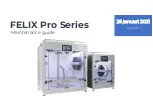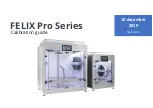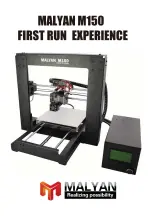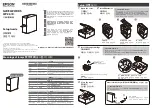
-
-
59
4.5 Lead-free solder instructions
Components of this printer requiring solder in its manufacture use lead-free soldering technology.
Please apply lead-free solder to weld panel when repairing it.
NOTE: Mixing different types of soldering materials, such as lead-free with leaded solder, is
prohibited.
The following information explains how to use lead-free solder to weld PCB when repairing:
1. The characteristics of lead-free solder
•
Melting temperature of lead-free solder is higher than that of ordinary solder.
(Lead-free solder: about 220
℃
. Ordinary lead solder: about 180
℃
)
•
Compared with ordinary solder, lead-free solder takes more time to solidify making
fusing more difficult.
•
Compared with ordinary solder, lead-free solder has relatively lighter welding dampness
and infusibility (hard to dampen and spread) and also has a hard surface (dark grainy
surface).
•
Greater welding time.
•
Inferior heat-conduction and greater heat-resistance (hard to melt)
2. The printer exterior
The exterior parts of printer with lead-free solder appear the same as those with lead-based
solder, except the following items:
•
The part with lead-free solder is darker and rougher.
•
The part with lead-free solder will display shrinkage cracking. (Observed by 10 times
magnification.)
3. The “lead-free” mark on PCB
Mark “LF” with silkscreen printing or with a label on the PCB that uses lead-free solder:
“LF” refers to “lead-free” and also indicates that PCB with this mark is welded by lead-free
solder.
4. Precautions for manual solder operation
1
)
The application of lead-free solder is the same as lead solder, however, because lead-free
solder is difficult to melt, damp, spread and harden, it takes longer for welding with
lead-free than with ordinary lead solder. Please make sure that the lead-free solder is spread
sufficiently when welding. The amount of solder needs to be increased when repairing the
PCB and it is better to wait for the previous weld area to be completely melted, and then do
so. When the repair is unsatisfactory, the unsatisfactory part of the soldering must be
cleared completely, and then use new lead-free solder.
2
)
Before welding, please verify whether there is a “LF” mark on PCB. If there is a mark
identified “LF” on PCB, please use lead-free solder which corresponds with the figure on
the back of “LF” mark. Please do not use ordinary solder which contains lead (lead solder)
on PCB with the “LF” mark. (It is forbidden to apply lead solder to PCB which is marked
by “LF”.)
Содержание P1000 Series
Страница 1: ...Pantum Monochrome Laser Printer Service Manual P1000 P2000 Series...
Страница 8: ...vii 6 3 4 Paper jam 79 6 3 5 Image defects 83...
Страница 9: ...1 Chapter 1 Product description 1 1 Features 1 2 Overview 1 3 Specification...
Страница 12: ...4 1 2 2 Rear view 1 USB interface connector 2 Power receptacle 3 Power switch Right side cover Rear cover...
Страница 39: ...31 Chapter 3 Operation Theory 3 1 Electronic Configuration 3 2 Structure...
Страница 43: ...35 3 2 Construction 3 2 1 Print engine imaging system...
Страница 52: ...44 4 2 Disassembly flow chart...
Страница 56: ...48 then release them to remove the top cover...
Страница 58: ...50 2 Release bottom screws 3 Loosen hooking tabs gently and then remove the right side cover...
Страница 69: ...61 Chapter 5 Regular maintenance 5 1 Cleaning Inside Printer 5 2 Consumables Replacement...
Страница 73: ...65 Chapter 6 Error indications and troubleshooting 6 1 Introduction 6 2 Error Indications 6 3 Trouble shooting...
Страница 89: ...81 Paper Jam at the print cartridge unit 1 Open the discharge tray 2 Release the print cartridge...
















































